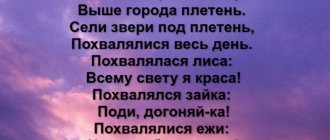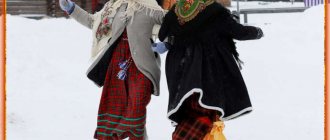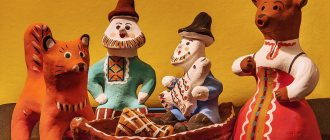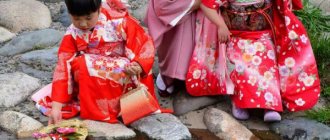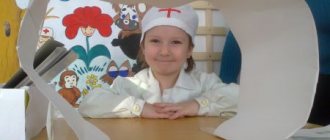Holiday of Russian folk games
Entertainment “Festival of Russian Folk Games”
Target. Introducing middle preschool children to Russian folk traditions through outdoor games.
Tasks.
1. Talk about Russian folk traditions and outdoor games.
2. Develop coordination of movements, dexterity, courage. Build the ability to interact.
3. Foster love and interest in Russian folk culture.
Equipment. An old chest, handkerchiefs, a cap, audio recordings of Russian songs.
Progress of entertainment
Presenter. Dear guys, today we have gathered to talk about antiquity, to play Russian folk games that our grandparents played. I invite you to a celebration of Russian folk games.
The Russian people have always been very fond of holidays. Everyone put on their beautiful outfits, went to visit, sang songs, danced, danced in circles and played fun games. Let's you and I, let's not break traditions, and start our holiday with a cheerful round dance.
(Children perform a round dance)
Presenter: A thousand games on our holiday! We play, joke, sing and dance! Don't open your mouth in games - Show courage and dexterity!
And you, brave and dexterous?
Children: Yes.
Presenter: Then I suggest you play the game “Burners”. Children stand in 2 columns of 6 people. The leader with a handkerchief (6 in total) stands on the opposite side of the teams. The first in both teams run around their team first, and then try to be the first to take the handkerchief from the driver. The team with the most handkerchiefs wins.
(Children sit on chairs)
Presenter: I hear something terrible! Someone is coming here to us... .
Petrushka enters.
Parsley: Hello, kids, girls and boys! I'm a fun toy. And my name is... (Parsley) . So I came to visit you.
Parsley - Tell me, guys, how did you spend your day? Presenter : – We’ll tell you everything in order: we did exercises in the morning. Parsley - How? Presenter : – Yes, that’s it.
Do exercises to music
Parsley - And then? Presenter : – We sat down for breakfast, and everyone ate without leaving a trace. Parsley - How? Presenter : - Yes, that’s it.
They show how to eat with a spoon while listening to music
Parsley - And then? Presenter: - We all walked in the yard and shoveled snow.
Parsley - How? Presenter: – Yes, that’s it.
They remove snow with shovels while listening to music
Parsley - And then? Presenter: - And then they played snowballs and hit each other. Parsley : How?
Presenter: Yes, that's it.
They perform movements to the music, like making snowballs.
Parsley - And then? Presenter: “ We sat down to dinner and everyone ate with appetite.”
Parsley - How? Presenter: Yes, that's it.
It’s like they’re having lunch while listening to music.
Parsley - And then? Presenter : - Everyone went to bed. Parsley - How?
Presenter: Yes, that's it.
Parsley : Yes, I see, kids, you had a nice day.
Have a great rest!!!
Presenter. Look guys, and you are Petrushka, what an interesting chest I have, what do you think you could have stored in it before? (children's answers). Previously, our ancestors used to store new clothes or clothes they wore on holidays in chests. Well, Petrushka, let's look into our chest (the presenter takes out a Russian scarf). Look how beautiful the Russian folk scarf is. In the old days, women wore the most beautiful scarves for the holidays, and men gave scarves to their lovers. But handkerchiefs were not only worn and admired, but also used in games.
I suggest we play one of these games now.
A new game is waiting for you - “Golden Gate”! (a game is being played).
"Golden Gate"
Progress of the game. The players choose two leaders. After this, the presenters take the ends of the scarf and lift it up, forming a “golden gate”. The remaining participants in the game line up one after another and go through the “gate” in single file, while saying:
Golden Gate
They don't always miss!
Saying goodbye for the first time
The second time is prohibited
And for the third time
We won't miss you!
At the last word, the presenters lower their hands and close the “gate,” holding one of the players with a handkerchief. Whoever gets caught in the gate does something, pays off (song, riddle verse, dance). In order not to be caught, those walking involuntarily speed up their pace, sometimes start running, and those catching, in turn, change the speed of the recitative. The game becomes more active and fun.
Presenter. Since ancient times, the Russian people have been called “hospitable” because they greeted guests with respect. The most delicious treats were prepared for the guests, the most favorite of which were pies, which were baked in a Russian oven and the smell from which floated throughout the entire area. You guys love pies, what filling do you have? (children's answers).
Let's play a game called “Pie”.
Russian folk game "Pie"
Description: The players stand in a circle. A “pie” sits in the middle (with a hat on it). Everyone starts baking a “pie” together:
Let's bake a pie
We knead the dough, knead it, knead it (imitate it with our hands)
And then we bake, bake, (sculpt with our hands)
Look how tall he is (raise their hands up)
This is how wide it is (take a step backwards and spread their arms to the side)
Look how soft it is (crushes with hands)
Cut him (waving finger)
Eat it!
After these words, the players run to the “pie”. Whoever reaches the goal faster and touches the “pie” sits in his place.
Presenter. As you guys know, before there were no televisions and people did not watch movies and cartoons, but told children fairy tales that they composed themselves. They also loved to ask riddles.
So I have prepared fabulous riddles for you.
Russian folk games
Fun, active games are our childhood. Who doesn’t remember the constant hide-and-seek, blind man’s buff, catch-up, and races? When did these games originate? Who invented them? It is probably impossible to find an exact answer to these questions. These games, like songs and fairy tales, were created by the people. They perfectly temper the body and soul. These games require a lot of movement, resourcefulness, ingenuity, dexterity and perseverance. They are usually held in the fresh air in an open area. Children of all ages can participate in such games. From preschoolers to high school students. Their rules are simple and clear.
- Salki
- Hide and seek
- Geese
- Burn-burn clear
- By the bear in the forest
- Beauties
- Zhmurki
- Alyonushka and Ivanushka
- Cossack robbers
- Fishing rod
- Cat and mouse
- Drive more quietly
- Ali Baba and the breaking chains
- 12 sticks
- Elephant
- Alyonushka and Ivanushka
- Hunters and ducks
- Crows and sparrows
- Border guards and violators
- Fight in squares
- Counter relay race with obstacles
- Plant and collect
- Hit the cap with a twig
- Mazay
- Burners
- I'm coming
- Handkerchief
- Astronauts
- Catch-up
- Hunters and ducks
- Train
- Fast skier
- Rooster fight
- Tag marching
- Running for flags
- Lapta
- Fives attack
- Rattling stick
- Zhmurki
- Team tagging
- Find your home
- Sniper relay
- Mountain
- Who is bigger
- Snowball racing
- Ice
- Sled relay
- Ball tag
- Grandmas
- Russian folk games
- Russian folk games 2
- Russian folk games 3
- Russian folk games 4
- Russian folk games 5
- Russian folk games 6
- Russian outdoor games
- Russian outdoor games 2
- Outdoor games for Russian children
- Games and nursery rhymes on the holiday of Ivan Kupala
- Slavic games
- Slavic Games
- Good games and fun
- Pebble games
- Russian folk group games
- Pebble games
- Games with songs and round dances
- Russian folk games by section
- Russian folk outdoor game "Big Lapta"
Additionally
- Slavic games for children
- Russian folk games
- Methodological manual for holding the “Peace Games” Voronezh-Moscow 2008
Links
- Russian folk games on bibliotekar
- Game program “Golden Gate” at the museum
- Cossack nursery rhymes, games and fun on scarb
- Russian folk games on folkgame
- Toys, riddles, games, nursery rhymes... at dom-teremok
- Russian folk outdoor game “kila”
Literature
- "Games for all ages Part 1" (1844)
- “Games for all ages Part 2” (1844)
- Pokrovsky E.A. "Children's Games, Mostly Russian" (1895)
- Volkov M. “Lapta: Rules and varieties of the game” (1915)
- Gerd I.Ya. “Games for children of all ages” (1926)
- Wagner G., Freyer K. “Children’s games and entertainment” (1902)
- Burtsev A.E. “Children's games and fun” (1911)
- Yakub S.K. “Remember the Forgotten Games” (1988)
"Folk outdoor games in preschool educational institutions"
- February 3, 2014
Competition “My Pedagogical Initiative - 2013”
Nomination “Methodological work in preschool educational institutions”
“Give children more and more general, human, world content, but mainly try to introduce them to this through native and national phenomena.” V. Belinsky.
Today we are beginning to look at many things differently, we are rediscovering and re-evaluating many things, this relates to the past of our people. Unfortunately, most people are very superficially familiar with Russian folk art. The native culture should become an integral part of the child, the beginning that gives rise to personality. You need to start introducing folk art from preschool age and best of all through play.
Tasks:
- introduce children to Russian folk art (games, counting rhymes),
- develop interest in the history of folk culture and folklore.
Our childhood is directly connected with the game. Children love to play various games, but most of all they love outdoor games. There are different types of outdoor games: plot-based and plot-free. But I would like to talk separately about folk outdoor games.
Folk games are accessible to children in their content. In the game, children improve their physical abilities and skills, increase motor activity, and develop physical qualities. Through folk games, children expand their horizons and gain ideas about the world around them. The rules of these games have great educational significance. They determine the entire course of the game, regulate the actions and behavior of children, and their relationships.
Folk games are often accompanied by funny moments, children’s favorite counting rhymes, drawing lots, and nursery rhymes, which have great aesthetic significance and constitute the most valuable, unique gaming folklore. So, for example, the beginnings are like a game prelude, they make it possible to quickly organize the players, set them up for an objective choice of the leader, unconditional compliance with the rules. In addition to counting rhymes, there are draws, which also create an emotional mood and captivate the game itself.
Clear counting rhymes, melodious and funny sing-alongs, entertaining dialogues are quickly and firmly remembered and are spoken with pleasure by children in their everyday games. Folklore is passed down orally from generation to generation and never grows old.
The teacher, creatively using the game as an emotional and imaginative means of influencing children, awakens their interest and imagination, achieving active performance of game actions. During the game, the teacher attracts the children’s attention to its content, monitors the accuracy of movements that must comply with the rules, the dosage of physical activity, gives brief instructions, supports and regulates the emotionally positive mood and relationships of the players, teaches them to act deftly and quickly in the created game situations, provide comradely support, achieve a common goal and experience joy at the same time.
The teacher should remember that his main task is to teach children to play actively and independently. Only in this case will they learn to regulate the degree of attention and muscle tension in any game situation, adapt to changing environmental conditions, find a way out of a critical situation, quickly make a decision and carry it out, show initiative, i.e. preschoolers acquire important qualities they need in the future.
Folk outdoor games in combination with other educational means represent the initial stage of the formation of a harmoniously developed, active personality, combining spiritual wealth, moral purity and physical perfection. When working with children, the teacher must remember that childhood impressions are deep and indelible in the memory of an adult. They form the foundation for the development of his moral feelings, consciousness and their further manifestation in socially useful and creative activities.
In the practice of preschool education, folk games are rare.
I believe that the proposed scenario will be of practical interest to those who want to expand children’s understanding of folk art. The task of the teacher and parents, or rather, their sacred duty, is to teach them to love their Motherland.
Physical education leisure for senior preschool age.
Lesson summary. Russian folk games.
Author: Kotova Elena Leonidovna, physical education instructor, MBDOU kindergarten No. 16 “Alenka”, Spassk-Dalniy, Primorsky Territory.
